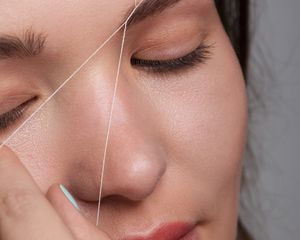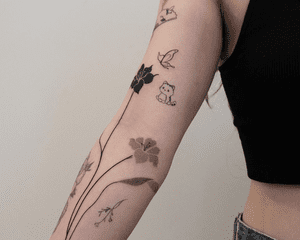When I post photos or TikTok dances on social media, I don’t pay any mind to what I’m wearing or if I’ve shaved. As I’ve gotten much more comfortable in my pandemic habits of showering and shaving less, I’ve started receiving many more private messages and comments on my content from people who express feeling surprised and seen when I post photos showing my armpit stubble.
I’ve always been very passionate about talking about essential life topics other people feel a tad uncomfortable to mention—specifically periods and mental health. In the last few years, I’ve found it important to understand where this stigma around shaving comes from. I have nothing against shaving, but I don’t think the pressure of such a strict and unrealistic beauty standard should exist. All people should shave when they want to or grow out their body hair if that feels good to them.
Women are expected to be hairless, but men aren't held to the same standards. In elementary school, I began feeling anxiety when I started seeing more noticeable hair appear on my shins. I spent hours late at night plucking out my armpit hair because I was so scared of it getting darker. Even today, I still look in the mirror and stress about the peach fuzz that creates the shadow on my upper lip.

Unsplash/Design by Cristina Cianci
According to a Market Analysis Report published by Grand View Research, the global laser hair removal market size was valued at $443 million in 2020 and is expected to grow at a compound annual growth rate of 20.6% from 2021 to 2028. This trend towards maintaining optimal aesthetic beauty is one of the major drivers of the market.
The traceable history of women shaving dates back to the Roman empire, where women removed their hair using a combination of chemicals, pumice, and even fire. It was reported that Queen Elizabeth would pluck her facial hair daily. It is also suggested that lower-class women, such as prostitutes and courtesans, would shave their entire bodies to conform to the male idea of female perfection, as portrayed in the sculptures of the Greeks and paintings of the Europeans.
Shaving for American women did not become popular until 1915. As arms and legs became more exposed due to fashion trends, Gillette created the Milady Décolleté razor sets around 1915, which subsequently launched an anti-underarm hair campaign. Razor ads urged women to remove "unsightly" and "objectionable hair" from their bodies, especially their underarms.
According to Anita Renfroe's book Don't Say I Didn't Warn You: Kids, Carbs, and the Coming Hormonal Apocalypse, the 1915 May edition of Harper's Bazaar published an ad showing a model in a sleeveless summer dress and bare armpits. This was supplemented by anti-underarm hair ads in McCall's magazine by 1917. Women's razors and depilatories showed up in the Sears, Roebuck catalog in 1922. Their purpose was to convince the public that feminine body hair was both "unladylike" and "unhygienic."
In my healing journey of reclaiming my body for myself, releasing the societal pressure to shave has been incredibly empowering.
During World War II, the wartime shortage of nylon meant women couldn’t wear stockings every day. More women shaved their legs because they had to go bare-legged and shaving leg hair soon evolved into a social norm. According to Rebecca Herzig, author of Plucked: A History of Hair Removal, by 1964, surveys indicated "98% of all American women aged fifteen to forty-four were routinely shaving their legs."
This way of thinking has become so ingrained in our society that most women never question the fact that they shave. Today, the rise of bare-skinned influencers and models on social media (as well as the pornography industry) has only solidified this beauty standard. I can almost guarantee most women have felt the weight of this expectation to shave. This was something I certainly struggled with, especially in my youth.

Unsplash/Design by Cristina Cianci
In my healing journey of reclaiming my body for myself, releasing the societal pressure to shave has been incredibly empowering. Now, I only shave when I want to.
Today, more people realize shaving is a social construct. Showing body hair and owning it has become more present in mainstream media. Supermodel Daria Werbowy showed off her armpit hair in an Instagram post; Ashley Graham recently posted a TikTok of her reacting to stories written about her unapologetically flaunting her body hair. Graham laughed as pictures of the headlines flashed behind her. In one scene, she lifted her arm and exposed some of her armpit hair proudly.
Like most societal beauty standards, the pressure to shave was created by men to control women. You should shave on your own terms. Choosing to embrace your body hair as is, keep it trimmed, or go completely bare is a personal decision. And ultimately, this choice should be based on what makes you feel confident and comfortable, period.
:max_bytes(150000):strip_icc()/Landingpage_hero_desktop-059cef5b387f4b40a3e1b4e31519834e.jpg)
:max_bytes(150000):strip_icc()/B-Sides_recirc1-981112ed82194a159178859896a85e55.jpg)
:max_bytes(150000):strip_icc()/managingsocialanxiety-RECIRC-fade19be96c54fbaa235c1bc61c6fe64.jpg)
:max_bytes(150000):strip_icc()/_USE-New-Edit-postcovidasian-RECIRC-fdd70af9dc784611be0525f8663aed3e.jpg)
:max_bytes(150000):strip_icc()/StatmentLip-RECIRC-2d4fa5792c5f43f18259f82eca700f3d.jpg)
:max_bytes(150000):strip_icc()/Gratitude-RECIRC-03f0d8b15a6845058bb2931fe8b84d1d.jpg)
:max_bytes(200000):strip_icc()/Shave-PrimarySF-b0ecfcc353eb4678806087dfc085e4a2.jpg)


